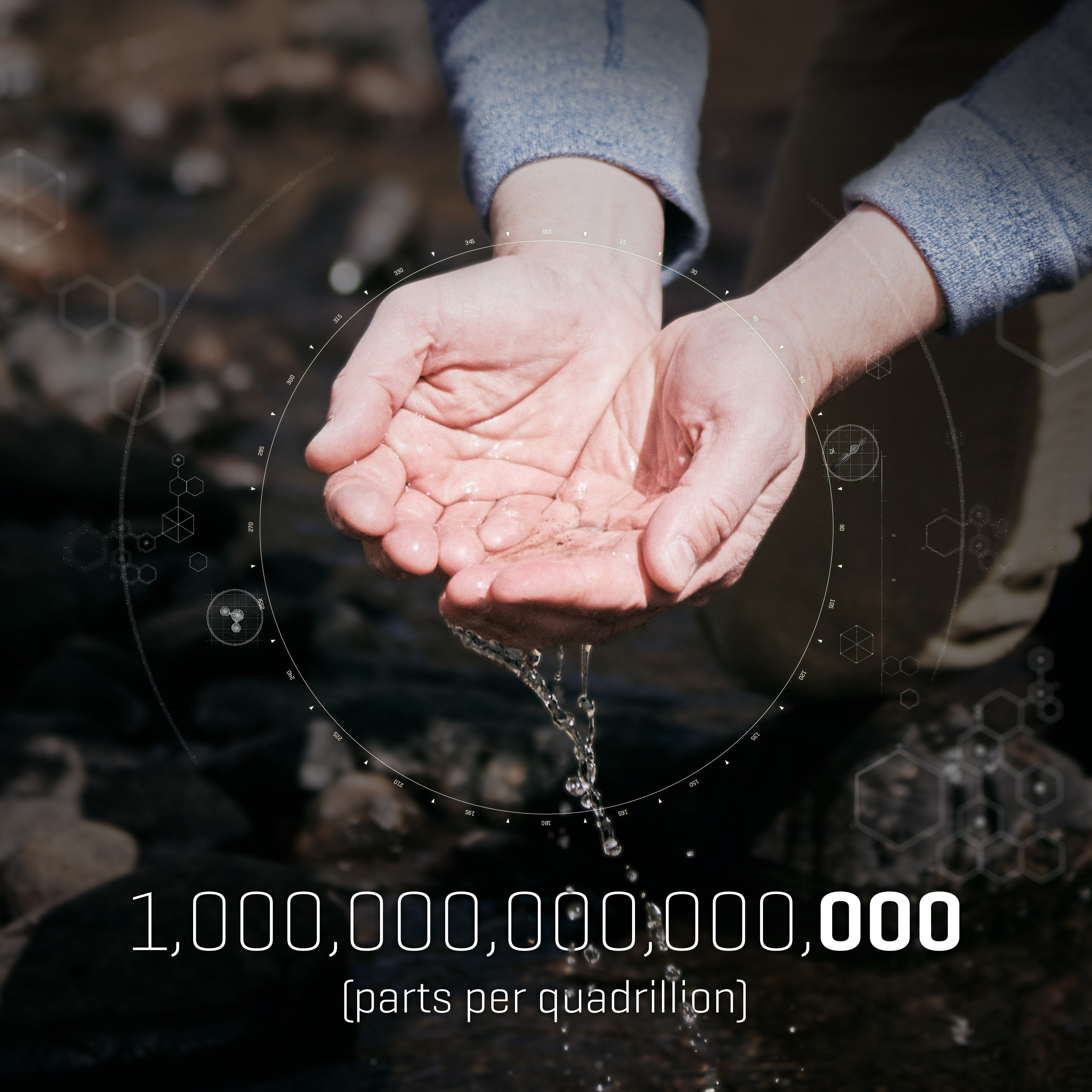SCIEX7500システム
微量濃度のPFAS化合物の究極定量には、SCIEX 7500システムが最適です。感度の向上により、サンプル前処理における濃縮ステップの必要性が減少します。
ペルおよびパーフルオロアルキル化合物(PFAS)の分析は、今や世界中の多くの環境ラボで日常的に行われている検査です。 環境サンプル中のPFAS化合物を幅広く測定するには、1兆分の1レベル(ppq)で高感度に定量ができ、メソッド全体を通して汚染の弊害がなく、注入毎に一貫性があり、正確で信頼性の高い結果が得られる、エンド・ツー・エンドのワークフローが求められます。
飲料水、原水、土壌のPFAS検査の需要は拡大しています。PFASの分析のニーズは、環境分析の一般的なマトリックスから、食品、動物組織、ヒトの体液へと移行しつつあります。したがって、ラボが実施する分析の種類に応じて、選択するワークフローは、PFASのさまざまなサンプルタイプを分析するために適応可能で堅牢である必要があります。


PFASワークフロー
2022年6月、EPAは、飲料水中のPFASに関する一連の新しい勧告レベルを発表しました* 小規模または不利なコミュニティにおける新興汚染物質(EC)助成金(SDC)| USEPA。SCIEXのPFAS専門家は、業界のリーダーと緊密に協力し、高感度な液体クロマトグラフ質量分析装置(LC-MS / MS)を用いて、これらの要件に対応するワークフローを開発しました。
また、欧州化学物質庁(ECHA)は、この化学物質群を含む広範な市販製品を対象とする普遍的なPFAS規制案と、一般的なガイダンスの実施スケジュールを発表しました。
これらのPFASワークフローは、パーフルオロオクタン酸(PFOA)、パーフルオロオクタンスルホン酸(PFOS)、GenX 化学物質、パーフルオロブタンスルホン酸(PFBS)などの主要な化合物の微量レベルの検出と定量を必要とします。SCIEXは、規制要件に対応するために必要なPFAS分析ソリューションと、お客様の技術予算に合わせたパッケージを提供します。
PFASライフサイクルのダウンロード微量濃度のPFAS化合物の究極定量には、SCIEX 7500システムが最適です。感度の向上により、サンプル前処理における濃縮ステップの必要性が減少します。
環境中には何千種類ものPFAS化合物が存在し、材料は日常生活のあらゆる側面で使用されています。SCIEX 7600システムは、新たな対象化合物の検出と特性解析を行う包括的な探索ワークフローを提供します。
この検証済みライブラリには、環境サンプルで一般的にテストされる96のフルオロケミカルとその代謝物のスペクトルが含まれており、複雑なサンプルのターゲットおよびノンターゲットスクリーニング用のメソッドとプロセスを簡単に作成できます。(v2.0には約250の化合物が含まれ、多くのAFFF由来の化合物が追加されています)
テクニカルノート
このメソッドでは、26種のPFAS化合物について、希釈液中のLOD値が0.2 ng/L、飲料水、地下水、地表水中のメソッド検出限界の計算値は0.06 ng/Lから1.12 ng/Lの範囲となり、1兆分の1(ppt)以下の検出レベルを達成しました。
テクニカルノート
SCIEX 7500システムによるPFASの超微量分析のための装置感度とサンプル前処理の共同研究。
データギャラリー

優れたリニアダイナミックレンジで2ng / Lのレポート下限を達成し、EPA 533およびUCMR5の要求事項を満たします。

EPAメソッド537.1ガイドラインに基づき、飲料水中の14種類のPFAS化合物をわずか10分で検出

液体クロマトグラフィー質量分析計を使用して水中のPFASとGenXの特性評価と定量を行い、規制値を満たします。
飲料水中の微量PFASを迅速、堅牢かつ正確に定量するために必要なツールとプロトコルを入手できます。
PFASおよびGenX化合物を確実に検出、定量、同定するための入門編ガイドがダウンロードできます。
液体クロマトグラフィー-タンデム質量分析(LC-MS / MS)技術は、飲料水、廃水、および土壌中の既知および未知のポリおよびペルフルオロアルキル化合物(PFAS)を検査するための分析科学への道を開きます。LC-MS/MSの感度と頑健性は、これらのユビキタスで難分解性の汚染物質を定量的に分析するのに理想的な選択肢です。
PFASは、ペルフルオロオクタン酸(PFOA)やペルフルオロオクタンスルホン酸(PFOS)などの合成化学物質の一群を指します。3,000種類以上のPFASが人間の健康と環境を脅かしており、PFAS検査は重要です。これらの化学物質は、水性フィルム形成フォーム(AFFF)、こびりつきにくい台所用品、水や油脂に強い接着剤などの製品の表面を作るために、1940年代から商業生産されてきました。
PFAS分析に関しては、システム汚染の可能性を最小限に抑えつつ、水、土壌、さらには食品などさまざまなマトリックス中の微量濃度のPFASをうまく測定するベストプラクティスを採用することが重要です。
LC-MS / MSは、次の理由により、環境サンプル中のPFASモニタリングに最適です。
LC-MS/MSは、PFASの検出、定量、そして理解への道を大きく変えました。SCIEX は、お客さまのラボが大量のサンプルと差し迫った期限という課題に直面しており、信頼性の低い機器システムは容認できないことを理解しています。ラボが新しいPFASを特定する必要がある場合でも、定期的に定量する必要がある場合でも、SCIEXのLC-MS/MSソリューションを使用したPFASテストは、生産性を最大限に高め、必要な高品質のデータを一貫して提供します。
グループ会社のPhenomenexは、積層固相抽出ソリューションから最適化されたLCカラムPFASセクションまで、PFASテストに必要なすべての消耗品とリソースを提供します。
Phenomenexが提供するPFASリソースをご覧ください:
リソース
PFASがどこにでも存在していることと環境サンプル分析におけるPFASの検出限界が継続的に低下していることを考えると、PFASのバックグラウンドを効果的に管理できるLC-MS戦略の必要性が高まります。ここでは、ExionLC 2.0システムにオプションの洗浄システムを組み合わせ、ディレイカラムを使用してサンプル分析からシステム由来のPFASのバックグラウンド汚染を分離するワークフローを確立しました。52種類のPFAS分析を使用し、キャリーオーバーを含むLCシステムの性能を確認しました。非常に高い感度でも問題ないことを確認するため、分析はSCIEX Triple Quad 7500システムを使用しました。
ペルおよびポリフルオロアルキル化合物(PFAS)は優れた防汚性を持つため、包装材料、消火泡など多くの用途で広く使用されています。PFASは飲料水供給等のほぼすべての環境マトリックスに存在することが判明しているため、安全を確保するためのモニタリングが重要です。ここでは、SCIEX 7500システムを用いた水サンプル分析のためのPFAS化合物群に対する包括的な定量法を開発しました。この高感度システムは、分析した54種類の化合物に対して、SCIEX 6500+システムと比較して平均して約5.5倍のS/N向上を提供しました。
生体マトリックス中では、PFOSおよびPFHxSの[SO3]-フラグメントイオンをモニターする際に共溶出干渉があることが分かっています。ここでは、精密質量分析を使用して、これらの干渉からPFOSおよびPFHxSを質量分離しました。使用した分離法では、6.5 分のグラジエントを用いて干渉をクロマトグラフィー分離できました。干渉は、MS/MSフラグメントスペクトルとライブラリ検索を使用して特性評価されました。
SCIEX 5500+システムを使用したEPAメソッド5331による飲料水中のPFAS分析。優れた感度と精度が示されました。「サンプル内」最小報告限界は、PFHpAを除くすべての測定化合物で2 ng/L、PFHpAで4 ng/Lでした。新しいペルフルオロエーテルカルボン酸およびスルホン酸が標準物質として0.50 ng/mLで検出され、これはサンプル中で2 ng/Lに相当し、PFOSおよびPFOAの70 ng/Lという米国EPAの飲料水ガイドラインをはるかに下回ります。SCIEX OS ソフトウェアのカスタム計算とフラグ付けルールがデータのレビューとレポート生成を効率化します。
ペルおよびポリフルオロアルキル化合物(PFAS)は、水源に滲出し、流域生態系で生物濃縮することが知られている人工化学物質のグループです。そのため、米国EPAは、EPAメソッド533でのPFASに対する最大残留基準(MRL)を提案する第5次未規制汚染物質監視規則(UCMR5)を発行しました。ここでは、固相抽出(SPE)とSCIEX Triple Quad 4500システムを使用し、22種類のPFASをモニタリングするメソッドを開発しました。感度と再現性は、EPAメソッド533の化合物のUCMR5要件を満たしていました。
このテクニカルノートでは、SCIEX X500 QTOFシステムを使用してヒト血清中のPFASを分析しました。自動ライブラリマッチングを備えた偏りのない非標的ワークフローにより、より広範で包括的なサンプル分析が可能になりました。さらに、効率化されたサンプル前処理は、サンプルの完全性を維持しつつ、ラボの効率向上へつながります。
ポリおよびペルフルオロアルキル化合物 (PFAS) は広く使用されており、現在では環境中で広く検出されています。製造されている PFAS は推定で 5,000 種類はあり、特定の PFAS 化合物の同定は困難です。構造の割り当ては高品質な MS/MS スペクトルの取得に依存しますが、従来の衝突誘起解離法 (CID) では、決定的な割り当てを提供するのに十分な情報が得られるとは限りません。ここでは、EAD (電子励起解離) を評価し、この直交フラグメンテーション モードが PFAS 構造の定性的な解明を改善できるかどうかを判断しました。
GenXはPFOAの代替化学物質であり、製造工場付近の環境でGenX汚染が増加していることが報告されています。HRMS は、追加の選択性が得られるため、複雑なマトリックスにおいてこのような新しい PFAS 化合物を監視する上で重要です。ここでは、水および堆積物サンプル中のGenX(HFPO-DA)および短鎖類縁体を含むペルフルオロアルキルエーテルカルボン酸(PFECAs)を検出するためのターゲットメソッドを、SCIEX X500 QTOFシステムを使用して開発しました。選択性が向上し、低から中程度のpptレベルの検出限界が得られました。
飲料水の安全性とヒトの健康を守るため、EPA は汚染物質検出のメソッドを公開しています。EPAメソッド537.1は、飲料水中の特定のペルおよびポリフルオロアルキル物質の検出について説明しています。ここでは、PFAS 検出のために QTRAP 4500 システムを使用して堅牢な LC-MRM 法を開発しました。EPA メソッド 537 の 14 種類の PFAS 化合物すべてについて、0.08-0.2 ng/L のMDL が達成され、 10 分の実行時間で米国 EPA の UCMR3 リストの要件を満たすか上回りました。
このテクニカルノートでは、水サンプル中のペルおよびポリフルオロアルキル化合物(PFAS)の定量のための2つの方法について説明します。いずれの方法でも、17種類を超えるPFASについて約1-10ng / Lのレベルで正確な定量を達成しました。メソッド1 は、EPA メソッド537 と互換性があります。
PFAS は、食品を包むプラスチック包装材料や、フライパンのノンスティックコーティングとして広く使用されています。MRMHR定量により、EU規制や中国の国家規準を満たすPFAS の検出および定量が可能になります。
Gen-Xは新興のポリフルオロアルキル物質で、ヘキサフルオロプロピレンオキシド(HFPO-DA)であり、他の新しい PFAS とともに、多成分 PFAS分析法の一部として示されています。Gen-XおよびいくつかのPFOS代替化合物は、SCIEX Triple Quad 4500システムで最適化されました。
現在、世界市場で販売されているまたはされた ペルおよびポリフルオロ化合物は3000 以上あります。規制の変化やヒトと環境への影響の懸念から、PFAS(ペルフルオロアルキルおよびポリフルオロアルキル化合物)の検出と同定は、多くの環境試験ラボにとって最優先事項となっています。これらの製品の多くは十分に理解されていない場合が多く、特性の記述も不十分であり、また分析用の標準物質が入手できないことが多いため、メソッドに含まれる対象となるPFASは限られます。そのため、多くのラボでは日常的な分析にサスペクトスクリーニングワークフローを取り入れています。サスペクトスクリーンニングにより、標準品を使用せずに特性評価された化合物のスペクトル ライブラリまたはデータベースを検索できるため、時間を節約し、環境サンプルのより包括的な特性評価が可能になります。
QTRAP 6500+ システムでは、少量の直接注入法を使用した正確で堅牢な LC-MRM 法が開発され、欧州当局が飲料水に対して設定した2020年2月時点の推奨制限 を容易に満たす感度が実証されています。この方法では、いくつかのPFAS特有の分析課題を解決しており、ラボに容易に導入できるようになっています。また、SCIEX 7500システムを用いたデータにより、感度向上の利点が際立っています。
ここでは、血清中の 22種類の PFAS を分析するための SCIEX QTRAP 6500+ システムを使用した包括的なワークフローを紹介します。このターゲットスクリーニングワークフローは、ヒト血清中の PFAS をng / mL未満の濃度で正確に定量できる迅速で堅牢かつ高感度な分析方法を示しています。血清中の 22種類の PFAS を分析するための SCIEX QTRAP 6500+ システムを使用した包括的なワークフローをご覧ください。このターゲットスクリーニングワークフローは、ヒト血清中の PFAS をナノグラム未満のレベルで正確に定量するための迅速で堅牢かつ高感度の分析方法を提供できることが示されています。
この方法では、26 種類の PFAS 化合物の検出レベルはサブppt に達し、希釈液中の LOD 値は 0.2 ng/L で、飲料水、地下水、表層水における計算上の検出限界は 0.06 ng/L から 1.12 ng/L の範囲でした。
痕跡レベル(ppt)のPFAS定量は、高感度なトリプル四重極質量分析計により日常的に行うことができます。PFAS、PFOA、PFOS、GenXなどは高い精度で検出および測定できます。ただし、ヒト血清中には PFAS の「未知」物質が大量に存在し、未知物質を特定するには QTOF を使用した高度な精密質量ワークフローが必要です。高分解能MRM定量にサスペクトスクリーニングが可能な非標的データ取込みを組み合わせたターゲット血清分析では、フラグメントの特異性を伴う化合物同定が可能になります。この動画シリーズで、ヒト体内のPFASの検出方法をご覧ください。
環境曝露による人体への PFAS の生体蓄積は、公衆衛生上の懸念となりつつあります。最近の研究によると、PFAS 曝露が、小児健康問題、腎機能低下、甲状腺疾患、ホルモン抑制、生殖能力の低下、コレステロール値の上昇、糖尿病など、健康に悪影響を及ぼすことが示されています。
この共同テクニカルノートでは、PFASの2022年EPA飲料水健康勧告値に必要な超微量検出レベルを達成する能力を実証しました。今後の実験では、PFOAとPFOSについて、それぞれ4ppq(pg/L)と20ppq(pg/L)の添加レベルでのMDL研究が行われる予定です。
このテクニカルノートでは、固相抽出(SPE)を使用せず、シンプルなサンプル前処理アプローチを使用して、海水中の低ng/LレベルのPFASを定量する手法を紹介します。SCIEX 7500システムの感度により、直接注入分析のみで未添加の海水サンプル中のPFASを超微量レベルで定量することができました。
ISO 21675は、水質サンプル中の30種類のPFAS化合物を分析するための国際標準規格です。現在、国内外の主な規制の対象となっているPFAS類には、PFOA、PFOS、PFHxS、PFNAなどが挙げられますが、近年では代替PFASの使用も増えています。このため、環境においてはより幅広いPFASのモニタリングが重要となり、HFPO-DA(GenX)のような代替PFASもカバーするこのメソッドは国内でも広く使用されています。SCIEXでは、ISO21675で測定対象となっている30種類のPFAS測定に関するアプリケーション情報も提供しています。
No resources found.

サステナビリティ
SCIEXは、エネルギー効率を高め、再生可能エネルギーシステムを導入し、資源を無期限に再利用する循環型廃棄物モデルを通じて廃棄物を最小限に抑えることにより、事業の環境への影響を減らすことを目指しています。研究開発とサービス部門は、グローバルな製造部門全体で徹底したサステナビリティへの取り組みを通じて、これを達成することを目指しています。詳細はこちら:
SCIEXのサステナビリティ